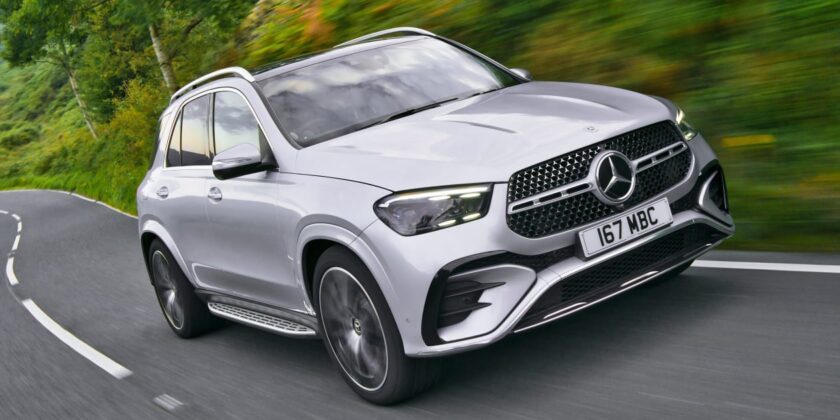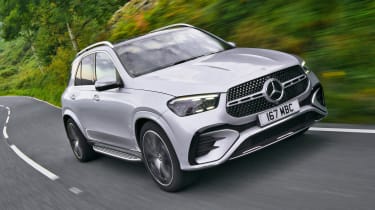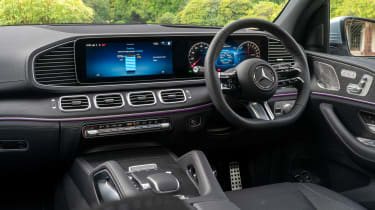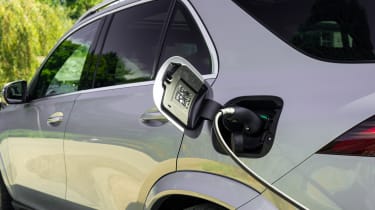Mercedes take on the high-end plug-in SUV places more emphasis on EV attributes than its rivals – for better and for worse
3.5 out of 5
How we review carsFind your Mercedes GLEOffers from our trusted partners on this car and its predecessors…
This has other ramifications for the driving experience, too. The e-motor has plenty of performance for low-speed driving, and will comfortably cruise at motorway speeds, but when the petrol engine is called on it will bark into life without much subtlety. By comparison, the BMW’s six-cylinder is almost imperceptible when it interrupts proceedings, only raising its voice when you call for full power.
The calibration of the GLE’s transitions between petrol and electric running is well considered and reactive to driver inputs but the petrol engine is just too unrefined, counting as a significant downmark for the whole experience.
Refinement elsewhere is generally good, though, as it rides well – even on the larger wheel options – and has very good insulation from wind and road noise. Brake pedal feel is also quite good for the class, and the Mercedes definitely has more adjustability and consistency than its plug-in rivals, which can often have an inconsistent or dead feeling brake pedal.
When roads get tighter, or if you want to up the pace, the GLE’s driving experience isn’t as nailed down as those of the BMW or Porsche, either. The extra few hundred kilograms of kerb weight make the GLE feel more ponderous and cumbersome to drive as the roads get twisty, and despite feeling planted at high speeds, the relatively fast steering ratio can feel out of step with the loose body-control.
There is a positive to the GLE’s mass, though, and it’s in the extra space afforded by the comparatively wide body. The second row has lots of leg, knee and headroom, with plenty of shoulder room to sit three adults abreast. The boot is also exceptionally large, with a wide and low opening that has 630-litres of space (130-litres more than the X5 for comparison).
When you’re in the cabin you can’t help but notice that due to almost no changes in the recent refresh, it feels a generation or so behind the class leaders. Its dual-screen setup is clean and Merc’s MBUX user interface is relatively easy to navigate with some prior exposure, but most rivals come with more modern features and slicker interfaces. Overall quality is only fine too, the GLE feeling less solid than the Cayenne and less plush than an X5.
In isolation the GLE400e is a good luxury SUV, with lots of space and a flexible powertrain that, if you regularly charge it up, works well in most situations. However the GLE sits in a very crowded and competent marketplace. BMW’s latest X5 plug-in is a stand-out both in terms of its superb powertrain and excellent comfort levels, while the Porsche Cayenne is more dynamic and feels better built. If you’re after ultimate luxury then the Range Rover Sport is also in the mix. It’s a similar price if you opt for one of the Merc’s upmarket Premium or Premium Plus trim levels.
In reality, the GLE’s only trump card seems to be its ability for fast DC charging. With the petrol engine more than flexible enough to support long journeys and a home charging point likely to be available to most owners considering the GLE’s price and market placement, this attribute is unlikely to sway many people. If it is a priority, then this might be the luxury SUV for you – for everyone else BMW and Porsche make a couple of deeply impressive alternatives.
| Model: | Mercedes-Benz GLE400e AMG Line |
| Price: | £82,255 |
| Engine: | 2.0-litre turbo-petrol, plug-in hybrid |
| Power/torque: | 375bhp/650Nm |
| Transmission: | Nine-speed auto, four-wheel drive |
| 0-62mph: | 6.1 seconds |
| Top speed: | 155mph |
| Economy/CO2: | 282mpg/22g/km |
| On sale: | Now |
Source: Read Full Article





